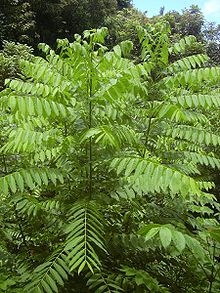bio.wikisort.org - Plant
Cedrela odorata is a commercially important species of tree in the chinaberry family, Meliaceae, commonly known as Spanish cedar or Cuban cedar; it is also known as cedro in Spanish.[3]
This article needs additional citations for verification. (December 2012) |
| Cedrela odorata | |
|---|---|
 | |
Conservation status | |
| Scientific classification | |
| Kingdom: | Plantae |
| Clade: | Tracheophytes |
| Clade: | Angiosperms |
| Clade: | Eudicots |
| Clade: | Rosids |
| Order: | Sapindales |
| Family: | Meliaceae |
| Genus: | Cedrela |
| Species: | C. odorata |
| Binomial name | |
| Cedrela odorata | |
| Synonyms[2] | |
|
List
| |
Classification
This section needs additional citations for verification. (March 2017) |
The genus Cedrela has undergone two major systematic revisions since 1960. The most recent revision reduced the number of species in the genus to seven (Styles, 1981). The common cedro, Cedrela odorata L., embraces 28 other synonyms, including C. mexicana M. J. Roem. The taxon "C. angustifolia," a very vigorous type now in demand because of its apparent resistance to the shootborer, was left in an indeterminate status due to insufficient herbarium material. The result is that C. odorata as now constituted is a species showing a high degree of population variation.
Distribution and habitat

Cedro is a tree of the New World tropics, appearing in forests of moist and seasonally dry subtropical or tropical life zones (24) from latitude 26°N on the Pacific coast of Mexico, throughout Central America and the Caribbean, to the lowlands and foothills of most of South America up to 1,200 metres (3,900 ft) altitude, finding its southern limit at about latitude 28°S in Argentina. It has become a troublesome invasive species in the Galapagos Islands.[4] Cedro is always found naturally on well-drained soils, often but not exclusively on limestone; it tolerates a long dry season but does not flourish in areas of rainfall greater than about 3,000 millimetres (120 in) or on sites with heavy or waterlogged soils. Individual trees are generally scattered in mixed semi-evergreen or semi-deciduous forests dominated by other species. Mahogany, a close relative, is often found with cedro and both suffer damage from the same pest, the mahogany shootborer (Hypsipyla grandella).
Description
The tree is monoecious semi-deciduous ranging in height from 10 to 30 m (33 to 98 ft). The trunk has a thick grey–brown bark, with longitudinal irregular grain. Pinnately compound leaves, grouped towards the end of the branches, 15–50 cm (5.9–19.7 in) long, with pairs of scythe-shaped leaflets, lanceolate to oblong, 7–15 cm (2.8–5.9 in) × 3–5 cm (1.2–2.0 in) with the base obliquely truncated and asymmetric.
Uses
Cedrela odorata is the most commercially important and widely distributed species in the genus Cedrela. Known as Spanish cedar in English commerce, the aromatic wood is in high demand in the American tropics because it is naturally termite- and rot-resistant. An attractive, moderately lightweight wood (specific gravity 0.4), its primary use is in household articles used to store clothing. Cedro heartwood contains an aromatic and insect-repelling resin that is the source of its popular name, Spanish-cedar (it resembles the aroma of the unrelated true cedars (Cedrus spp.) Cedro works easily and makes excellent plywood and veneer and would be more widely used if it could be successfully plantation grown. This plant is often used for honey production (beekeeping) and humidor construction. It is occasionally used for tops or veneers on some kinds of electric guitars. The wood is the traditional choice for making the neck of flamenco and classical guitars.[5]
See also
- Cedar wood
- List of honey plants
References
- Mark, J.; Rivers, M.C. (2017). "Cedrela odorata". IUCN Red List of Threatened Species. 2017: e.T32292A68080590. doi:10.2305/IUCN.UK.2017-3.RLTS.T32292A68080590.en. Retrieved 19 November 2021.
- "The Plant List: Cedrela odorata L." Royal Botanic Gardens, Kew and Missouri Botanic Garden.
- Selected plants of Galapagos Islands
- "Forest of daisy trees in Santa Cruz | Wondermondo". 11 March 2012.
- Romanillos, J.L. (2014) Making A Spanish Guitar
External links
 Data related to Cedrela odorata at Wikispecies
Data related to Cedrela odorata at Wikispecies- Cedro Hembra, Spanish-Cedar
- Overview of Cedrela odorata
На других языках
[de] Westindische Zedrele
Die Westindische Zedrele (Cedrela odorata), auch Westindische Zeder, Spanische Zeder oder nach ihrem verkürzten spanischen Namen Cedro genannt, ist eine Pflanzenart in der Familie der Mahagonigewächse (Meliaceae). Diese Art wächst von Mexiko über die Karibik und Mittelamerika bis ins tropische Südamerika. Sie wurde im Pazifik auf Hawaii und den Galapagosinseln, im Indischen Ozean auf Madagaskar sowie in den afrikanischen Staaten Südafrika, Tansania, Ghana, Sierra Leone, Nigeria und Elfenbeinküste eingeführt.[1]- [en] Cedrela odorata
[es] Cedrela odorata
Cedrela odorata, llamado comúnmente cedro americano,[1] es un árbol de la familia de las Meliáceas de la zona intertropical americana.[1] Su madera tiene un gran valor comercial que por su calidad se utiliza en ebanistería y carpintería, también se usa como árbol ornamental en avenidas, parques, plazas.[2][ru] Цедрела душистая
Цедре́ла души́стая (лат. Cedrela odorata) — типовой вид рода Цедрела (Cedrela) семейства Мелиевые (Meliaceae).Другой контент может иметь иную лицензию. Перед использованием материалов сайта WikiSort.org внимательно изучите правила лицензирования конкретных элементов наполнения сайта.
WikiSort.org - проект по пересортировке и дополнению контента Википедии
